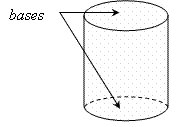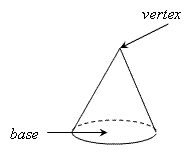 username@email.com
username@email.com
In the coming lesson, we’ll review the basic three-dimensional figures and some of their properties.
A polyhedron is a three-dimensional solid, each face of which is a polygon. Each pair of faces meet at an edge. The corners of the edges meet at points called vertices.
 |
A prism is a polyhedron that has two parallel, congruent faces called bases. The other faces are parallelograms.
This rectangular prism has six faces, twelve edges, and eight vertices. |
 |
A cube is a prism whose faces are squares.
This cube has six faces, twelve edges, and eight vertices. |
 |
A pyramid is a polyhedron whose base is a polygon and whose faces are triangles with a common vertex.
This triangular pyramid has four faces, six edges, and four vertices. This square pyramid has five faces, eight edges, and five vertices. |
These are solids that are not formed by polygons.
 |
A cylinder is a solid whose bases are circles. |
 |
A cone is a solid with one circular base and one vertex |
 |
A sphere is the set of all points in space that are equidistant from a given point called the center. |
How many more vertices than a rectangular pyramid does a rectangular prism have?
The correct answer is C. A rectangular prism has eight vertices and a rectangular pyramid has five.